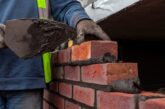
Gareth Davies, technical advisor at Tarmac Cement offers some essential advice to builders on working with cement in the colder months.
With the colder months approaching, the construction industry has an altogether different and challenging task on their hands. When the first frosts bite, even the most thought out of projects can experience kinks in productivity. As such, those planning outdoor building projects should consider winter specific complications, and most importantly, plan ahead in order to execute their operations effectively.
Preparing for frost
A critical factor for works carried out in cold weather is ensuring that the mortar or concrete has adequate heat for normal cement hydration. The usability and strength of mortar is affected by temperature, and additional care must be taken when working with a mortar mix in colder conditions. Cement will not hydrate sufficiently at low temperatures (hydration will virtually stop below three degrees Celsius), which increases the likelihood of slow setting and poor strength gains, as well as frost damage and freeze-thaw attack on hardened mortar or concrete.
It seems obvious, but this can be easily managed by avoiding mixing or laying the mortar or concrete when the air temperature is below 5ºC. It’s also important to keep the mortar or concrete protected for three to seven days. Cement curing is an exothermic chemical reaction, so the coverings you use will not only trap the moisture required for hydration of the cement but additionally some of the heat generated; this helps to ensure the mortar or concrete remains above 5ºC and allows it to continue to gain strength.
Also, freezing temperatures significantly reduce the compressive strength, the bond strength and also decreases the resistance to water penetration of masonry. If the newly placed mortar does fall below freezing before developing enough strength, it will often result in cracking, scaling and crumbling of the product.
Although the best advice is to wait for temperatures above 5ºC before doing these jobs, the formation of cracks and spalls are annoyingly unpredictable. In any case, when getting the job done is essential, and there is a risk of frost, protect the mortar with an insulation quilt sandwiched between two sheets of polythene sheeting.
The elements
It’s not just frost that you need to consider. A great deal of judgment is required to perform construction projects in wind and rain.
Severe wind can cause premature drying as a result of increased evaporation. For this reason, it’s important to make the necessary arrangements to tackle the risk before laying concrete or placing mortar in a windy area. Consider putting up wind barriers to protect your work and secure the area with plastic sheeting.
Water is both the friend and foe of mortar and concrete. Add too much at any point in the mixing or installation process, and you can ruin the concrete or mortar, radically reducing its final strength and durability. Allowing too much water to evaporate from the concrete or mortar can also weaken the final product. Therefore, without adequate protection, you could be left with a weakened surface and further problems in the future. This might include dusting of the surface, shrinking, cracking, surface scaling and a porous surface that will allow far too much water to be absorbed, leading to a reduced ability of the slab or mortar to resist cracking due to freeze-thaw cycles. But the most serious consequence could be complete structural failure requiring removal and replacement. Protecting new concrete and mortar from the elements with a water-resistant tarp or plastic sheeting is therefore essential to aid curing and help form strong durable concretes and mortars.
The right product
Another significant factor to consider in the colder months is the quality of the mortar mix itself. Go for a leading manufacturer to ensure your product is air-entrained. Air-entrained mixes such as Tarmac Blue Circle Quality Assured Mortar contain billions of microscopic air pockets that relieve internal pressure on the mortar by providing small chambers for water to expand into when it freezes. This gives the mortar increased resistance to freeze/thaw degradation.
Packaging is also important when protecting against the elements. Often, the winter months can see cement spoilt when left open outside. To keep cement dry and prevent wastage, look for products that are available in weather resistant packaging and tubs. It sounds simple but doing this will save you the time and money associated with purchasing more cement.
To prolong the life of your tools and materials in the winter, and save money in the process, it’s important to give them extra care. The annoying job of chipping away at hardened dirt or mortar and removing rust in spring, can be prevented by keeping your tools clean and well-oiled throughout the colder months.
![]()







